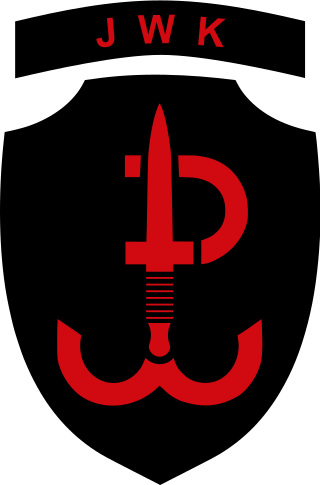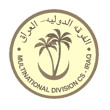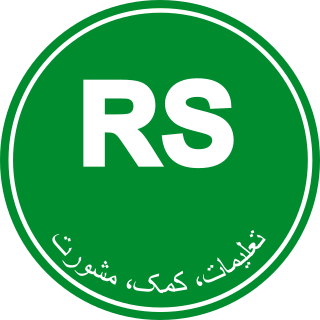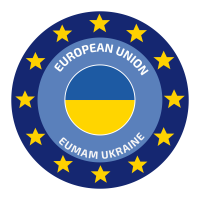
The North Atlantic Treaty Organization, also called the North Atlantic Alliance, is an intergovernmental military alliance of 32 member states—30 European and 2 North American. Established in the aftermath of World War II, the organization implements the North Atlantic Treaty, signed in Washington, D.C., on 4 April 1949. NATO is a collective security system: its independent member states agree to defend each other against attacks by third parties. During the Cold War, NATO operated as a check on the threat posed by the Soviet Union. The alliance remained in place after the dissolution of the Soviet Union and the Warsaw Pact, and has been involved in military operations in the Balkans, the Middle East, South Asia and Africa. The organization's motto is animus in consulendo liber. The organization's strategic concepts include deterrence.

The Polish–Soviet War was fought primarily between the Second Polish Republic and the Russian Soviet Federative Socialist Republic before it became a union republic in the aftermath of World War I and the Russian Revolution, on territories which were previously held by the Russian Empire and the Habsburg Monarchy following the Partitions of Poland.

The Polish–Russian War of 1792 was fought between the Polish–Lithuanian Commonwealth on one side, and the Targowica Confederation and the Russian Empire under Catherine the Great on the other.

The Home Army Silent Unseen Paratroopers GROM Military Unit, simply known as the GROM Military Unit, is a Polish special forces unit and forms part of the Special Troops Command of the Polish Armed Forces. It is believed to consist of around 250 operatives plus support personnel. GROM is considered to be the most elite unit in the Polish Armed Forces.

The Russian Air Force is a branch of the Russian Aerospace Forces, the latter being formed on 1 August 2015 with the merging of the Russian Air Force and the Russian Aerospace Defence Forces. The modern VVS was originally established on 7 May 1992 following Boris Yeltsin's creation of the Ministry of Defence. However, the Russian Federation's air force can trace its lineage and traditions back to the Imperial Russian Air Service (1912–1917) and the Soviet Air Forces (1918–1991).

The Jednostka Wojskowa Komandosów, commonly called JWK and formerly known as 1 Pułk Specjalny Komandosów, is one of six special forces units currently operating within Poland's Centrum Operacji Specjalnych - Dowództwo Komponentu Wojsk Specjalnych. JWK was formed in 1961 and is the oldest still active Polish special operations unit. The unit is located in Lubliniec, Poland.

The 14th Waffen Grenadier Division of the SS , commonly referred to as the Galicia Division, was a World War II infantry division of the Waffen-SS, the military wing of the German Nazi Party, made up predominantly of volunteers with a Ukrainian ethnic background from the area of Galicia, later also with some Slovaks.

The Ukrainian Ground Forces, also referred to as the Ukrainian army, are the land forces of Ukraine and one of the eight branches of the Armed Forces of Ukraine. They were formed from Ukrainian units of the Soviet Army after Ukrainian independence, and trace their ancestry to the 1917–22 army of the Ukrainian People's Republic.

Polish–Ukrainian Peace Force Battalion (POLUKRBAT) or Ukrainian-Polish Peace Force Battalion (UKRPOLBAT) is a Polish-Ukrainian peacekeeping battalion, formed in the late 1990s expressly "for participation in international peace-keeping and humanitarian operations under the auspices of international organizations".

The 30th Prince Konstanty Ostrogski Mechanized Brigade is a formation of the Ukrainian Ground Forces. The full name of the unit is 30th Independent Mechanized Brigade "Konstanty Ostrogski".

The Ukrainian Air Assault Forces, known until 2017 as the Ukrainian Airmobile Forces are the airborne forces of Ukraine. After the Dissolution of the Soviet Union in 1991, several Ukraine-based units from the Soviet Airborne Forces were absorbed into the newly-created Ukrainian Ground Forces, where they remained until 2016, when they separated to become one of five branches of the Armed Forces of Ukraine. The Air Assault Forces are in constant combat readiness. They are the high-mobility branch of the military, responsible for air assaults and military parachuting operations. Before the Russo-Ukrainian War they were also the main forces sent by Ukraine to peacekeeping missions around the world. They are considered the elite of Ukraine's armed forces.

Multinational Division Central-South (MND-CS), created in September 2003, and supported by NATO, was a part of the Multinational Force Iraq. Headquartered in Camp Echo, it was under Polish command until October 2008, when the last of Poland's troops were withdrawn. The Polish contingent was its largest. Other participants included Armenia, Bosnia and Herzegovina, Bulgaria, Denmark, Kazakhstan, Latvia, Lithuania, Mongolia, Norway, Romania, El Salvador, Slovakia, Spain, Ukraine and the United States of America. As of December 2008, Armenian, Bosnian, Danish, Latvian, Kazakh, Lithuanian, Mongolian, Spanish and Slovakian forces had been fully withdrawn.

The Western Military District was a military district of Russia, in existence from 2010 until its abolishment as a unitary military command on February 26, 2024, succeeded by the newly reconstituted Moscow Military District and Leningrad Military District.

The National Guard of Ukraine is the Ukrainian national gendarmerie and internal military force. It is part of the Ministry of Internal Affairs, responsible for public security. Originally created as an agency under the direct control of the Verkhovna Rada on 4 November 1991, following Ukrainian independence, it was later disbanded and merged into the Internal Troops of Ukraine in 2000 by then-President Leonid Kuchma as part of a "cost-saving" scheme. Following the 2014 Revolution of Dignity, amidst the Russian intervention, the National Guard was re-established, and the Internal Troops were disbanded.

Resolute Support Mission (RSM) or Operation Resolute Support was a NATO-led multinational mission in Afghanistan. It began on 1 January 2015 as the successor to the International Security Assistance Force (ISAF), which was completed on 28 December 2014. Pursuant to United Nations Security Council Resolution 2189 of 2014, RSM was a noncombat mission aimed at advising and training Afghan security forces to provide long-term security to the country, under the aegis of the Security and Defence Cooperation Agreement BSA between the United States and Afghanistan, which was originally supposed to run from 1 January 2015 and "shall remain in force until the end of 2024 and beyond" unless terminated with two years' advance notice.

Operation Freedom's Sentinel (OFS) was the official name used by the U.S. government for the mission succeeding Operation Enduring Freedom (OEF) in continuation of the War in Afghanistan as part of the larger Global War on Terrorism. Operation Freedom's Sentinel is part of the NATO-led Resolute Support Mission, which began on January 1, 2015. OFS had two components: counterterrorism and working with allies as part of Resolute Support.
This is the order of battle for the Russian invasion of Ukraine. It should not be considered completely up to date nor accurate, being based on open-source press reporting.
Ukraine Security Assistance Initiative or USAI is a U.S. Department of Defense-led funding program to increase Ukraine's capacity to defend itself more effectively against Russian aggression through the further training of its Armed Forces, equipment, and advisory initiatives.

Operation Interflex is the operational code name for the British-led multinational military operation to train and support the Armed Forces of Ukraine. It is a successor to Operation Orbital (2015–2022) and began in July 2022. Unlike its predecessor, Operation Interflex takes place within the United Kingdom and is supported by contingents from international partners.

The European Union Military Assistance Mission in support of Ukraine is the European Union's (EU) first military assistance mission for Ukraine set up on 17 October 2022. The decision to establish EUMAM was made by the Council of the European Union in response to Ukraine's request for military support during the ongoing Russian invasion of the country. The primary aim of the mission is to provide training to the Armed Forces of Ukraine in the territory of the EU member states.


















